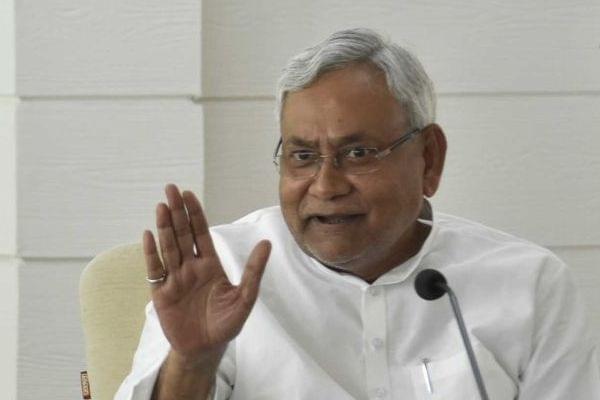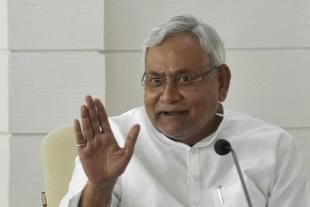Politics
Nitish Kumar Has Been Wrongly Associated With ‘Good Governance’, Sushasan Babu Tag Sits Badly On Him
Jaideep Mazumdar
Aug 17, 2022, 07:40 PM | Updated 09:10 PM IST
Save & read from anywhere!
Bookmark stories for easy access on any device or the Swarajya app.


Bihar chief minister Nitish Kumar, in popular imagination, possesses excellent governance skills and is a good administrator. In fact, he is widely known by the sushasan babu moniker.
But that reputation is completely ill-deserved. Kumar has not stood out as a good administrator not only as Bihar’s long-serving chief minister, but also as a two-term Union Railway Minister.
The only achievement that Kumar can lay claim to is putting an end to the jungle raj that prevailed during the long tenure of the Rashtriya Janata Dal (RJD) in Bihar.
Kumar restored the rule of the law in Bihar after coming to power in the state for the second time in November 2005 (his first stint as CM was for only seven days) and jailed a large number of criminals who were patronised by the RJD.
In fact, Nitish Kumar came to power on the promise of ending Lalu Yadav’s jungle raj when murders, rapes, dacoities, kidnappings for ransom and extortions were rife and RJD’s musclemen had become a law unto themselves.
Nitish Kumar also ended, to a large extent, the endemic corruption that marked the RJD’s years in power. Bihar had become notorious for largescale loot of the public exchequer during the chief ministership of Lalu Yadav and his wife Rabri Devi. Kumar managed to put a stop to that.
But that’s where his ‘achievements’ as Bihar’s chief minister end. Nitish Kumar has singularly failed to turn around Bihar’s fortunes and tackle rampant unemployment, improve agricultural productivity, healthcare and education, public delivery services and bring about any significant change in the state’s finances.
Nitish Kumar has been chief minister of Bihar for nearly 16 years now and, thus, had ample time to improve the dismal situation in Bihar, which continues to remain the least developed among all Indian states.
Bihar’s per capita income is the lowest in the country, and it has been consistently ranked as the worst-performing state as far as healthcare, education, agricultural productivity, industrial output and public delivery services is concerned. Bihar lags behind the rest of the country in all social indices as well as development parameters.
Nitish Kumar has been a failure in attracting investments and, thus, creating jobs in Bihar. The sushasan babu image created by his spin-doctors has failed to fool potential investors who continue to give Bihar a wide berth.
Bihar’s per capita GSDP is the lowest in the country at Rs 50,555 (compared to all-India per capita GDP of Rs 1,46,087). Bihar’s fiscal deficit in the last financial year was 11.31 per cent of the state GSDP, much higher than the 4.5 per cent deficit permitted by the Union government.
The CAG report on Bihar for the 2020-21 financial year serves as a damning indictment of Nitish Kumar. Bihar’s fiscal debt has been rising every year and in 2020-21, it stood at Rs 29,827 crore, which was an increase of Rs 15, 103 crore over the previous financial year.
Bihar’s outstanding public debt in 2020-21 stood at a whopping Rs 1,77,214.85 crore, which was an increase of Rs 29,035 crore over the previous year. The CAG sounded a severe warning that Bihar’s outstanding debt is getting closer to its annual budget (in that financial year, the state’s total expenditure was Rs 1,65,696 crore).
With limited means to generate revenue on its own--it has barely any industries and agriculture is largely non-productive while the services sector generates little in a state ridden by poverty and unemployment--Bihar has fallen into a debt trap where it has to borrow to service its existing debt.
Most of Bihar’s borrowings (82.94 per cent) go to discharge existing liabilities, leaving little for capital formation and development.
The CAG, in its report for 2020-21, also red-flagged Bihar’s financial indiscipline. Utilisation certificates (a statement of accounts supported by bills for expenditure incurred on development works and welfare measures) for works and projects amounting to Rs 92,687.31 crore were pending at the end of that financial year.
Failure to submit utilisation certificates not only amounts to fiscal indiscipline, but also points to misappropriation of funds and frauds, the CAG noted in its report.
Though agriculture employs 76 per cent of Bihar’s workforce, the state has 1.83 crore landless labourers. The average agricultural landholding size is 0.39 hectare, thus making 1.64 crore farm landholdings unviable.
Nitish Kumar did little to increase agricultural productivity by increasing the area under irrigation, extending loans to farmers and hand-holding them, improving agricultural practices and modernising this sector through reforms.
Bihar has, admittedly, witnessed a lot of improvement in infrastructure. New roads and bridges have come up and existing ones have been upgraded. Once notorious for its broken bridges and cratered roads, Bihar presents a totally different picture now. But Nitish Kumar cannot take major credit for any of that: all these works were funded by the Union government, especially under Prime Ministers Atal Behari Vajpayee and Narendra Modi. And most of those works were also undertaken or overseen by central agencies.
Nitish Kumar’s lacklustre performance as chief minister of Bihar is hardly surprising, considering the fact that he was a failure as the Union Railway Minister before that.
Nitish Kumar was railway minister for two terms--from March 1998 to August 1999 and then from March 2001 to May 2004. He was one in the long line of railway ministers who were responsible for Indian Railways becoming synonymous with terrible public amenities, frequent mishaps, late running trains and creaking infrastructure.
Only since 2014, and especially under Suresh Prabhu, his successor Piyush Goyal and the incumbent Ashwini Vaisnaw, has Indian Railways effected a turnaround.
As railway minister, Nitish Kumar took the path of his predecessors and indulged in unbridled populism like increasing the number of trains without any thought to the collapsing infrastructure of the public sector behemoth, and creating new railway zones in order to provide jobs to party faithfuls.
Nitish Kumar is wrongly credited with introducing the internet ticket booking system in 2002. Fact is, the Railway Board had been working on this proposal at the urging of the IT Ministry and had planned to introduce it in 2002. Nitish Kumar took undeserved credit for it since he unveiled it.
Union Rural Development Minister Giriraj Singh, who has been keeping a close eye on Nitish Kumar's performance, says that the Bihar chief minister has always been successful in creating a false hype about himself as a good administrator.
“He is friendly with some influential mediapersons and has them eating out of his hands. They have created this false hype about Nitish Kumar. But if one looks closely at his performance as railway minister and then as chief minister, it will be clear that Nitish Kumar is a failed administrator. He did nothing for the railways and has done little for Bihar,” said Singh.
If one goes by statistics and the ground realities in Bihar, Singh could not be more right.
Jaideep Mazumdar is an associate editor at Swarajya.





